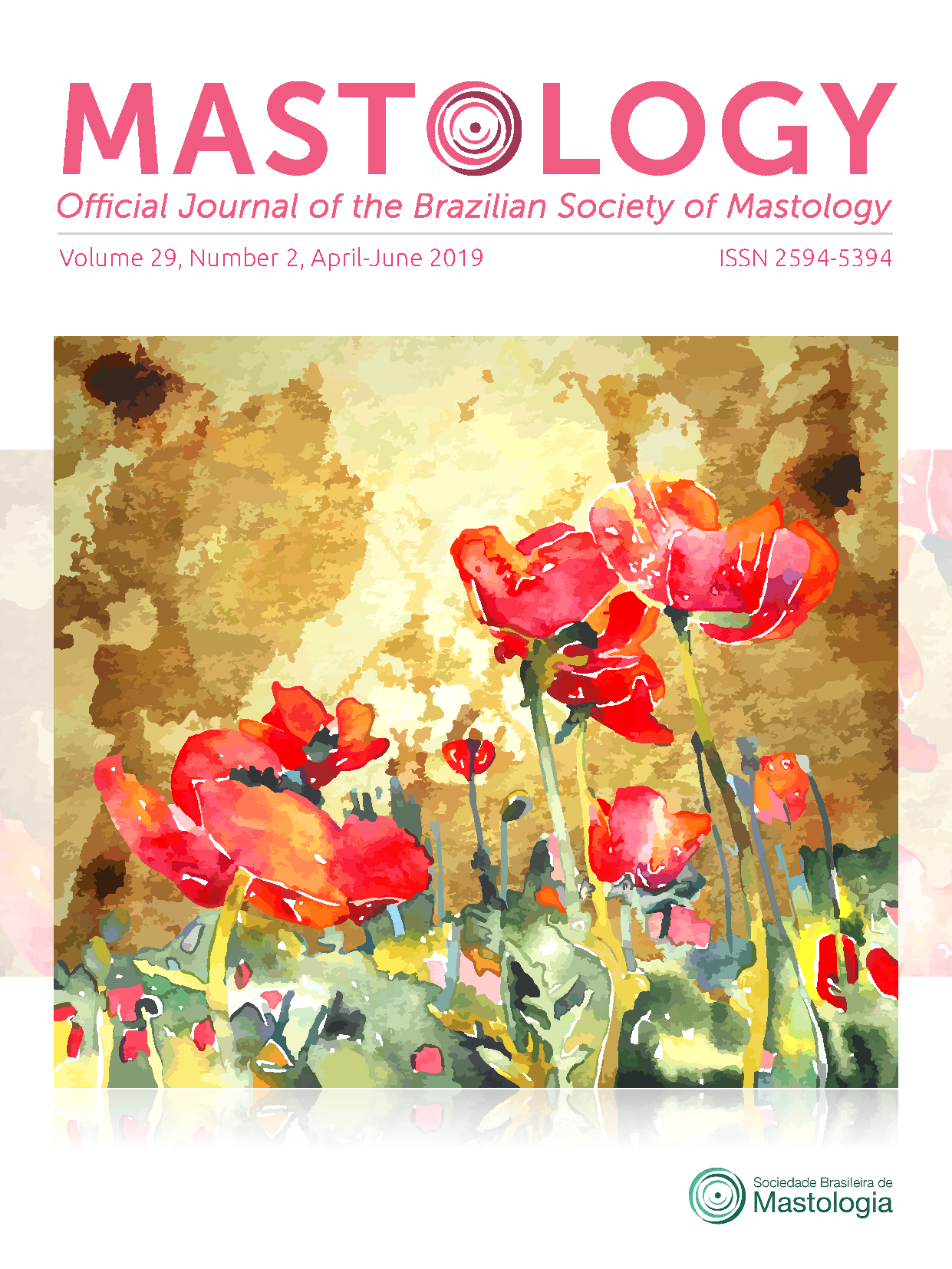USE OF DYE IN THE PREOPERATIVE MARKING OF NONPALPABLE BREAST
LESIONS LITERATURE REVIEW
Keywords:
breast, coloring agents, breast neoplasms, breast cancerAbstract
Objective: To evaluate and compare the use of different dyes in the marking of nonpalpable breast lesions indicated for surgical resection. Method: We analyzed the following variables: number of cases, types of dye, technique used for marking (patent blue, indocyanine green, or methylene blue), associated techniques (guidewire or Tc-99m), free margins of the surgical specimen (when the diagnosis was cancer), pain during the marking, and allergic events. The main results of the articles were organized in tables, using the software Microsoft Excel 2011. Results: We selected 11 articles for analysis. A total of 510 women had 516 nonpalpable breast lesions marked with dyes. The main dyes used were patent blue, methylene blue, and indocyanine green. The rate of free margins in cancer cases was 95%. Methylene blue was superior to other dyes in obtaining free margins. Out of the 11 articles selected, three associated dye with radioactive materials, and two with guidewire. Two studies analyzed the pain during the marking and revealed that 75% of the patients classified it as moderate or minimal, with mammography being the method most associated with pain. No allergic event was reported. Conclusion: The use of dyes in the preoperative marking of nonpalpable breast lesions is a viable, safe, and cheap technique. The initial results of several groups indicate significant advantages compared to the methods currently available. Methylene blue has a lower rate of positive margins than other dyes. Prospective randomized studies are still necessary to verify the superiority of the technique in comparison to others.
Downloads
References
Vieira SC, Alves VC, Oliveira TCB, Ibiapina JO, Soares ECA, Crisanto MLLP. Azul patente e ar como uma alternativa para a resseccao de lesoes nao-palpaveis de mama: serie de casos. Sao Paulo Med J. 2014;132(1):10-4. http://dx.doi.org/10.1590/1516-3180.2014.1321559
Nasrinossadat A, Ladan F, Fereshte E, Asieh O, Reza C, Akramossadat S, et al. Marking non-palpable breast masses with injected methylene blue dye, an easy, safe and low cost method for developing countries and resource-limited areas. Asian Pac J Cancer Prev. 2011;12(5):1189-92.
Tang J, Xie XM, Wang X, Xie ZM, He JH, Wu YP, et al. Radiocolloid in combination with methylene dye localization, rather than wire localization, is a preferred procedure for excisional biopsy of nonpalpable breast lesions. Ann Surg Oncol. 2011;18(1):109-13. https://doi.org/10.1245/s10434-010-1207-9
Liu J, Guo W, Tong M. Intraoperative indocyanine green fluorescence guidance for excision of nonpalpable breast cancer. World J Surg Oncol. 2016;14(1):266. https://doi.org/10.1186/s12957-016-1014-2
Aydogan F, Ozben V, Aytac E, Yilmaz H, Cercel A, Celik V. Excision of nonpalpable breast cancer with indocyanine green fluorescence-guided occult lesion localization (IFOLL). Breast Care (Basel). 2012;7(1):48-51. https://doi.org/10.1159/000336497
Tang J, Wang X, Wu YP, Wang X, Lian ZQ, Fu JH, et al. Significance of methylene blue dye for localization biopsy of nonpalpable breast lesions. Ai Zheng. 2009;28(1):79-81.
Eulalio Filho WMN, Medeiros Neto AM, Teles JB, Vieira SC. Evaluation of pain during breast injury nonpalpable realization of achievement with blue patent. Rev Bras Mastologia. 2016;26(1):9-12.
Padua Filho AF, Vieira SC, Viana DKO, Almeida SFA, Ribeiro, SCSJ, Sousa Junior WO, et al. Resseccao de lesoes impalpaveis de mama marcada com azul patente e ar. Rev Bras Mastologia. 2004;14(2):57-60.
Zografos GC, Doumitriou C, Lappas D, Karatzikos G, Bami E, Fotiadis C, et al. Localization of nonpalpable breast lesions using hook-wire combined with isosulfan blue dye. J Surg Oncol. 2003;82(1):73-4. https://doi.org/10.1002/jso.10119
Zgajnar J, Besic N, Frkovic´-Grazio S, Hocevar M, Vidergar B, Rener M, et al. Radioguided excision of the nonpalpable breast cancer and simultaneous sentinel lymphnode biopsy using a single radiopharmaceutical: An Original Approach to Accurate Administration of the Blue Dye. J Surg Oncol. 2003;83(1):48-50. https://doi.org/10.1002/jso.10232
Cavalcanti TCS, Malafaia O, Nassif PAN, Skare TL, Ogata DC, Miguel MT, et al. Lesoes impalpaveis da mama marcadas com suspensao de carvao: avaliacao de aspectos anatomopatologicos, viabilidade de interpretacao e resposta inflamatoria. Rev Col Bras Cir. 2012;39(6):469-75. http://dx.doi.org/10.1590/S0100-69912012000600005
Moss HA, Barter SJ, Nayagam M, Lawrence D, Pittam M. The use of carbon suspension as an adjunct to wire localisation of impalpable breast lesions. Clin Radiol. 2002;57(10):937-44. https://doi.org/10.1053/crad.2002.0994
Czarnecki DJ, Feider HK, Splittgerber GF. Toluidine blue dye as a breast localization marker. AJR Am J Roentgenol. 1989;153(2):261-3.10.2214/ajr.153.2.261.
Mullan MH, Deacock SJ, Quiney NF, Kissin MW. Anaphylaxis to patent blue dye during sentinel lymph node biopsy for breast cancer Eur J Surg Oncol. 2001;27(2):218-9. https://doi.org/10.1053/ejso.2000.1030
Downloads
Published
How to Cite
Issue
Section
License
Copyright (c) 2019 Walberto Monteiro Neiva Eulálio Filho, Amanda Leal Guimarães, Antônio Marques de Medeiros Neto, Luana Araujo Borges de Moura, Carolina Gaze Gonçalves Fontenele Gomes, Sabas Carlos Vieira

This work is licensed under a Creative Commons Attribution 4.0 International License.







